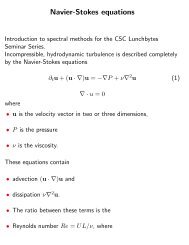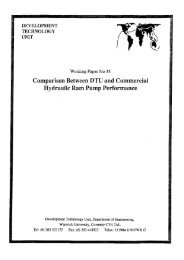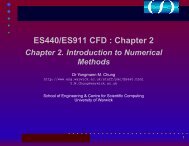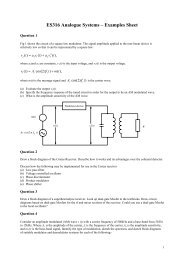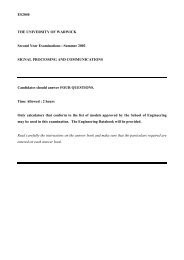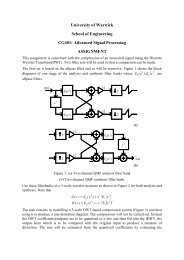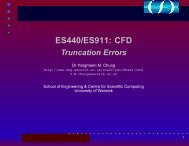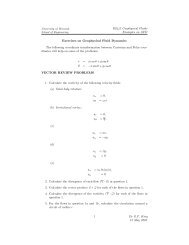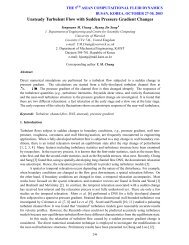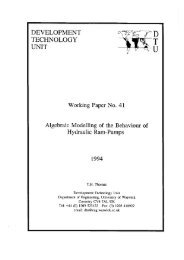Slides - School of Engineering - University of Warwick
Slides - School of Engineering - University of Warwick
Slides - School of Engineering - University of Warwick
Create successful ePaper yourself
Turn your PDF publications into a flip-book with our unique Google optimized e-Paper software.
ES440/ES911: CFD<br />
Chapter 3. Finite Difference Methods<br />
Dr Yongmann M. Chung<br />
http://www.eng.warwick.ac.uk/staff/ymc/ES440.html<br />
Y.M.Chung@warwick.ac.uk<br />
<strong>School</strong> <strong>of</strong> <strong>Engineering</strong> & Centre for Scientific Computing<br />
<strong>University</strong> <strong>of</strong> <strong>Warwick</strong><br />
1
Chapter 3<br />
Finite Difference Methods<br />
2
3.1 Introduction<br />
A generic transport equation<br />
∂ρu j φ<br />
∂x j<br />
= ∂<br />
∂x j<br />
(Γ ∂φ<br />
∂x j<br />
) + q φ . (3.1 F&P )<br />
3
3.1 Introduction<br />
A generic transport equation<br />
∂ρu j φ<br />
∂x j<br />
= ∂<br />
∂x j<br />
(Γ ∂φ<br />
∂x j<br />
) + q φ . (3.1 F&P )<br />
In Cartesian Coordinates,<br />
∂ρuφ<br />
∂x + ∂ρvφ<br />
∂y + ∂ρwφ<br />
∂z<br />
= ∂<br />
∂x (Γ∂φ ∂x ) + ∂ ∂y (Γ∂φ ∂y ) + ∂ ∂z (Γ∂φ ∂z ) + q φ.<br />
3
3.1 Introduction<br />
A generic transport equation<br />
∂ρu j φ<br />
∂x j<br />
= ∂<br />
∂x j<br />
(Γ ∂φ<br />
∂x j<br />
) + q φ . (3.1 F&P )<br />
In Cartesian Coordinates,<br />
∂ρuφ<br />
∂x + ∂ρvφ<br />
∂y + ∂ρwφ<br />
∂z<br />
= ∂<br />
∂x (Γ∂φ ∂x ) + ∂ ∂y (Γ∂φ ∂y ) + ∂ ∂z (Γ∂φ ∂z ) + q φ.<br />
Simplifications<br />
Convection Terms<br />
Diffusion Terms<br />
Source Term<br />
Unsteady Term (Ch. 6)<br />
3
3.2 Basic Concept<br />
First step is to discretise the geometric domain<br />
A numerical grid (or computational mesh) must be<br />
defined.<br />
Each node is uniquely identified by a set <strong>of</strong> indices, i in<br />
1D, (i, j) in 2D & (i, j, k) in 3D.<br />
4
3.2 - 1D Discretisation<br />
Divide the computational domain (L) using N grid points (or<br />
mesh points or nodes).<br />
x 1 , x 2 , x 3 , . . . , x i−1 , x i , x i+1 , . . . , x N−2 , x N−1 , x N .<br />
∆x i is the distance between the neighbour grid points.<br />
5
3.2 - Discretisation<br />
Each node has one unknown variable associated with it.<br />
1D: f 1 , f 2 , f 3 , . . . , f i−1 , f i , f i+1 , . . . , f N−2 , f N−1 , f N .<br />
2D: f 1,1 , f 2,1 , f 3,1 , . . . , f i−1,j , f i,j , f i+1,j , . . . , f N−1,N , f N,N .<br />
3D:<br />
f 1,1,1 , f 2,1,1 , f 3,1,1 , . . . , f i−1,j,k , f i,j,k , f i+1,j,k , . . . , f N,N,N .<br />
6
3.2 Basic Concept - Cont’d<br />
Uniform vs. Non-uniform grids<br />
7
3.2 Basic Concept - Cont’d<br />
Uniform vs. Non-uniform grids<br />
Structured vs. Unstructured.<br />
7
3.2 Basic Concept - Cont’d<br />
Each node has one unknown variable associated with it.<br />
∂ρu j φ<br />
∂x j<br />
= ∂<br />
∂x j<br />
(Γ ∂φ<br />
∂x j<br />
) + q φ . (3.1 F&P )<br />
8
3.2 Basic Concept - Cont’d<br />
Each node has one unknown variable associated with it.<br />
∂ρu j φ<br />
∂x j<br />
= ∂<br />
∂x j<br />
(Γ ∂φ<br />
∂x j<br />
) + q φ . (3.1 F&P )<br />
1D: f 1 , f 2 , f 3 , . . . , f i−1 , f i , f i+1 , . . . , f N−2 , f N−1 , f N .<br />
8
3.2 Basic Concept - Cont’d<br />
Each node has one unknown variable associated with it.<br />
∂ρu j φ<br />
∂x j<br />
= ∂<br />
∂x j<br />
(Γ ∂φ<br />
∂x j<br />
) + q φ . (3.1 F&P )<br />
1D: f 1 , f 2 , f 3 , . . . , f i−1 , f i , f i+1 , . . . , f N−2 , f N−1 , f N .<br />
2D: f 1,1 , f 1,2 , f 1,3 , . . . , f i−1,j , f i,j , f i+1,j , . . . , f N,N−1 , f N,N<br />
8
3.2 Basic Concept - Cont’d<br />
Replacing each term <strong>of</strong> the PDE by a finite-difference<br />
approximation.<br />
∂ρu j φ<br />
∂x j<br />
= ∂<br />
∂x j<br />
(Γ ∂φ<br />
∂x j<br />
) + q φ . (3.1 F&P )<br />
Convection Terms,<br />
Diffusion Terms,<br />
Source Term.<br />
9
3.2 Basic Concept - Cont’d<br />
A generic transport equation<br />
∂ρu j φ<br />
∂x j<br />
= ∂<br />
∂x j<br />
(Γ ∂φ<br />
∂x j<br />
) + q φ . (3.1 F&P )<br />
10
3.2 Basic Concept - Cont’d<br />
A generic transport equation<br />
∂ρu j φ<br />
∂x j<br />
= ∂<br />
∂x j<br />
(Γ ∂φ<br />
∂x j<br />
) + q φ . (3.1 F&P )<br />
The numbers <strong>of</strong> equations and unknowns must be equal<br />
∂ρu j φ 1<br />
∂x j<br />
∂ρu j φ 2<br />
∂x j<br />
= ∂<br />
∂x j<br />
(Γ ∂φ 1<br />
∂x j<br />
) + q φ , (1)<br />
= ∂<br />
∂x j<br />
(Γ ∂φ 2<br />
∂x j<br />
) + q φ , (2)<br />
∂ρu j φ N<br />
∂x j<br />
.<br />
= ∂<br />
∂x j<br />
(Γ ∂φ N<br />
∂x j<br />
) + q φ .<br />
(N)<br />
10
3.2 - Finite Difference Approximations<br />
The idea behind FD Approximations is borrowed directly<br />
from the definition <strong>of</strong> a derivative<br />
( ) df<br />
dx<br />
x i<br />
= lim<br />
∆x→0<br />
f(x i + ∆x) − f(x i )<br />
. (3.2 F&P )<br />
∆x<br />
11
3.2 - Finite Difference Approximations<br />
Three Approximations<br />
Forward difference: f(x i ) and f(x i + ∆x),<br />
Backward difference: f(x i − ∆x) and f(x i ),<br />
Central difference: f(x i − ∆x) and f(x i + ∆x).<br />
12
3.2 - Finite Difference Approximations<br />
Three Approximations<br />
Forward difference: f(x i ) and f(x i + ∆x),<br />
Backward difference: f(x i − ∆x) and f(x i ),<br />
Central difference: f(x i − ∆x) and f(x i + ∆x).<br />
12
Taylor Series Expansion<br />
Taylor Series Expansion<br />
Any continuous differentiable function f(x) can, in the<br />
vicinity <strong>of</strong> x i , be expressed as a Taylor series:<br />
f(x) = f i +∆x<br />
( ) ∂f<br />
+ 1 ( ∂ 2 f<br />
∂x<br />
i<br />
2! ∆x2 ∂x<br />
)i<br />
2 + 1 ( ∂ 3 f<br />
3! ∆x3 ∂x<br />
)i<br />
3<br />
· · · + 1 ( ∂ n f<br />
n! ∆xn ∂x<br />
)i<br />
n + H. (3.3 F&P )<br />
where H means all remaining HIGHER ORDER TERMS.<br />
+<br />
13
Taylor Series Expansion<br />
Taylor Series Expansion<br />
Any continuous differentiable function f(x) can, in the<br />
vicinity <strong>of</strong> x i , be expressed as a Taylor series:<br />
f(x) = f i +∆x<br />
( ) ∂f<br />
+ 1 ( ∂ 2 f<br />
∂x<br />
i<br />
2! ∆x2 ∂x<br />
)i<br />
2 + 1 ( ∂ 3 f<br />
3! ∆x3 ∂x<br />
)i<br />
3<br />
· · · + 1 ( ∂ n f<br />
n! ∆xn ∂x<br />
)i<br />
n + H. (3.3 F&P )<br />
where H means all remaining HIGHER ORDER TERMS.<br />
+<br />
Expressions for the variable values in terms <strong>of</strong> the variable<br />
and its derivatives at x i .<br />
( ) ( ∂f ∂ 2 f<br />
f i , ,<br />
∂x<br />
i<br />
∂x 2 )i<br />
,<br />
( ∂ 3 f<br />
∂x 3 )i<br />
, . . . ,<br />
( ∂ n f<br />
∂x n )i<br />
.<br />
13
3.3 - Forward Difference: ∂f<br />
∂x<br />
Each node has one unknown variable associated with it.<br />
x 1 , x 2 , x 3 , . . . , x i−1 , x i , x i+1 , . . . , x N−2 , x N−1 , x N .<br />
f 1 , f 2 , f 3 , . . . , f i−1 , f i , f i+1 , . . . , f N−2 , f N−1 , f N .<br />
14
3.3 - Forward Difference: ∂f<br />
∂x<br />
Each node has one unknown variable associated with it.<br />
x 1 , x 2 , x 3 , . . . , x i−1 , x i , x i+1 , . . . , x N−2 , x N−1 , x N .<br />
f 1 , f 2 , f 3 , . . . , f i−1 , f i , f i+1 , . . . , f N−2 , f N−1 , f N .<br />
Finite Difference Formulae can be easily derived<br />
By replacing x by x i+1 .<br />
f i+1 = f i + ∆x<br />
( ) ∂f<br />
∂x<br />
i<br />
+ 1 2! ∆x2 ( ∂ 2 f<br />
∂x 2 )i<br />
+ 1 3! ∆x3 ( ∂ 3 f<br />
∂x 3 )i<br />
+ H.<br />
14
3.3 - Forward Difference: ∂f<br />
∂x<br />
Each node has one unknown variable associated with it.<br />
x 1 , x 2 , x 3 , . . . , x i−1 , x i , x i+1 , . . . , x N−2 , x N−1 , x N .<br />
f 1 , f 2 , f 3 , . . . , f i−1 , f i , f i+1 , . . . , f N−2 , f N−1 , f N .<br />
Finite Difference Formulae can be easily derived<br />
By replacing x by x i+1 .<br />
f i+1 = f i + ∆x<br />
( ) ∂f<br />
∂x<br />
i<br />
+ 1 2! ∆x2 ( ∂ 2 f<br />
∂x 2 )i<br />
+ 1 3! ∆x3 ( ∂ 3 f<br />
∂x 3 )i<br />
+ H.<br />
14
3.3 - Forward Difference: ∂f<br />
∂x<br />
Taylor Series <strong>of</strong> f i+1 at x i+1 .<br />
f i+1 = f i + ∆x<br />
( ) ∂f<br />
∂x<br />
i<br />
+ 1 2! ∆x2 ( ∂ 2 f<br />
∂x 2 )i<br />
+ 1 3! ∆x3 ( ∂ 3 f<br />
∂x 3 )i<br />
+ H.<br />
15
3.3 - Forward Difference: ∂f<br />
∂x<br />
Taylor Series <strong>of</strong> f i+1 at x i+1 .<br />
f i+1 = f i + ∆x<br />
( ) ∂f<br />
∂x<br />
i<br />
+ 1 2! ∆x2 ( ∂ 2 f<br />
∂x 2 )i<br />
+ 1 3! ∆x3 ( ∂ 3 f<br />
∂x 3 )i<br />
+ H.<br />
Rearranging Eqn. (3.3) and dividing by the finite-difference<br />
∆x gives<br />
∂f<br />
∂x = f i+1 − f i<br />
∆x<br />
− 1 2!<br />
∂ 2 f<br />
∂x 2 ∆x − 1 3!<br />
∂ 3 f<br />
∂x 3 ∆x2 + H. (3.4 F&P )<br />
The first term is a Finite Difference Approximation.<br />
The next term is the Leading Error term: O(∆x).<br />
15
3.3 - Forward Difference - Cont’d<br />
Formula (3.4) is usually recast in the following form<br />
∂f<br />
∂x = f i+1 − f i<br />
∆x<br />
+ O(∆x). (3.7 FP )<br />
This is referred to as the first-order forward difference.<br />
The exponent <strong>of</strong> ∆x in the leading error term is the order<br />
<strong>of</strong> accuracy.<br />
It is a useful measure <strong>of</strong> accuracy.<br />
It gives an indication <strong>of</strong> how rapidly the accuracy can be<br />
improved with the refinement <strong>of</strong> the grid spacing.<br />
16
3.3 - Forward Difference - Cont’d<br />
u<br />
u i+1<br />
Predicted du/dx<br />
u i<br />
True du/dx<br />
u i-1<br />
∆x ∆x<br />
∂f<br />
∂x ≈ f i+1 − f i<br />
. (3.7 F&P )<br />
∆x<br />
Truncation Error:<br />
T.E. ∼ O(∆x).<br />
x i-1<br />
x i<br />
x i+1<br />
x<br />
17
3.3 - Backward Difference: ∂f<br />
∂x<br />
By expanding f i−1 about the point x i .<br />
f i−1 = f i − ∆x<br />
( ) ∂f<br />
∂x<br />
i<br />
+ 1 2! ∆x2 ( ∂ 2 f<br />
∂x 2 )i<br />
− 1 3! ∆x3 ( ∂ 3 f<br />
∂x 3 )i<br />
+ H.<br />
18
3.3 - Backward Difference: ∂f<br />
∂x<br />
By expanding f i−1 about the point x i .<br />
f i−1 = f i − ∆x<br />
( ) ∂f<br />
∂x<br />
i<br />
+ 1 2! ∆x2 ( ∂ 2 f<br />
∂x 2 )i<br />
− 1 3! ∆x3 ( ∂ 3 f<br />
∂x 3 )i<br />
+ H.<br />
Similarly, rearranging the above Eqn. (3.3) and dividing by<br />
the finite-difference ∆x gives<br />
∂f<br />
∂x = f i − u i−1<br />
∆x<br />
+ 1 2!<br />
∂ 2 f<br />
∂x 2 ∆x − 1 3!<br />
∂ 3 f<br />
∂x 3 ∆x2 + H. (3.5 F&P )<br />
The first term is a Finite Difference Approximation.<br />
The next term is the Leading Error term: O(∆x).<br />
18
3.3 - Backward Difference - Cont’d<br />
Formula (3.5) is usually recast in the following form<br />
∂f<br />
∂x = f i − f i−1<br />
∆x<br />
+ O(∆x). (3.8 FP )<br />
This is referred to as the first-order backward<br />
difference.<br />
u<br />
u i+1<br />
u i<br />
True du/dx<br />
Predicted du/dx<br />
u i-1<br />
∂f<br />
∂x ≈ f i − f i−1<br />
. (3.8 F&P )<br />
∆x<br />
Truncation Error:<br />
T.E. ∼ O(∆x).<br />
∆x<br />
∆x<br />
x i-1<br />
x i<br />
x i+1<br />
x<br />
19
3.3 - Central Difference: ∂f<br />
∂x<br />
Taylor Series <strong>of</strong> f i+1 & f i−1 at both x i+1 & x i−1 .<br />
( ) ∂f<br />
f i+1 = f i + ∆x + 1 ( ∂ 2 f<br />
∂x<br />
i<br />
2! ∆x2 ∂x<br />
)i<br />
2 ( ) ∂f<br />
f i−1 = f i − ∆x + 1 ( ∂ 2 f<br />
∂x<br />
i<br />
2! ∆x2 ∂x<br />
)i<br />
2<br />
+ 1 3! ∆x3 ( ∂ 3 f<br />
∂x 3 )i<br />
− 1 3! ∆x3 ( ∂ 3 f<br />
∂x 3 )i<br />
+ H,<br />
+ H.<br />
20
3.3 - Central Difference: ∂f<br />
∂x<br />
Taylor Series <strong>of</strong> f i+1 & f i−1 at both x i+1 & x i−1 .<br />
( ) ∂f<br />
f i+1 = f i + ∆x + 1 ( ∂ 2 f<br />
∂x<br />
i<br />
2! ∆x2 ∂x<br />
)i<br />
2 ( ) ∂f<br />
f i−1 = f i − ∆x + 1 ( ∂ 2 f<br />
∂x<br />
i<br />
2! ∆x2 ∂x<br />
)i<br />
2<br />
+ 1 3! ∆x3 ( ∂ 3 f<br />
∂x 3 )i<br />
− 1 3! ∆x3 ( ∂ 3 f<br />
∂x 3 )i<br />
+ H,<br />
+ H.<br />
The widely used central difference formula can be<br />
obtained from subtraction <strong>of</strong> two Taylor series expansions.<br />
∂f<br />
∂x = f i+1 − f i−1<br />
2∆x<br />
− 1 3!<br />
∂ 3 f<br />
∂x 3 ∆x2 − 1 5!<br />
∂ 5 f<br />
∂x 5 ∆x4 + H. (3.6 F&P )<br />
20
3.3 - Central Differences - Cont’d<br />
Formula (3.6) is usually recast in the following form<br />
∂f<br />
∂x = f i+1 − f i−1<br />
2∆x<br />
+ O(∆x 2 ). (3.8 FP )<br />
This is a second-order formula.<br />
u<br />
u i+1<br />
Predicted du/dx<br />
u i<br />
True du/dx<br />
u i-1<br />
∆x ∆x<br />
∂f<br />
∂x ≈ f i+1 − f i−1<br />
. (3.8 F&P )<br />
2∆x<br />
Truncation Error:<br />
T.E. ∼ O(∆x 2 ).<br />
x i-1<br />
x i<br />
x i+1<br />
x<br />
21
3.3 - Truncation Errors<br />
Numerically evaluated at x = 4.<br />
The absolute values <strong>of</strong> the differences from the exact<br />
solution.<br />
f(x) = sin x<br />
x 3 .<br />
With ∆x = 0.1<br />
f i−1 = −0.0115943,<br />
f i = −0.0118250,<br />
f i+1 = −0.0118726.<br />
22
3.3 - Fourth Order Accuracy<br />
In general, we can obtain higher accuracy if we include<br />
more points.<br />
Fourth Order Accuracy: T.E. ∼ O(∆x 4 ).<br />
23
3.3 - Fourth Order Accuracy<br />
In general, we can obtain higher accuracy if we include<br />
more points.<br />
Fourth Order Accuracy: T.E. ∼ O(∆x 4 ).<br />
Taylor Series <strong>of</strong> f i+2 , f i+1 , f i−1 & f i−2 at x i+2 , x i+1 , x i−1 &<br />
x i−2 .<br />
( ) ∂f<br />
f i+2 = f i + 2∆x + 1 ( ∂ 2 )<br />
f<br />
∂x 2! (2∆x)2 ∂x 2<br />
( ) ∂f<br />
f i+1 = f i + ∆x + 1 ( ∂ 2 )<br />
f<br />
∂x 2! ∆x2 ∂x 2<br />
( ) ∂f<br />
f i−1 = f i − ∆x + 1 ( ∂ 2 )<br />
f<br />
∂x 2! ∆x2 ∂x 2<br />
( ) ∂f<br />
f i−2 = f i − 2∆x + 1 ( ∂ 2 )<br />
f<br />
∂x 2! (2∆x)2 ∂x 2<br />
+ 1 3! (2∆x)3 ( ∂ 3 f<br />
∂x 3 )<br />
+ 1 3! ∆x3 ( ∂ 3 f<br />
∂x 3 )<br />
− 1 3! ∆x3 ( ∂ 3 f<br />
∂x 3 )<br />
+ H,<br />
+ H,<br />
− 1 3! (2∆x)3 ( ∂ 3 f<br />
∂x 3 )<br />
+ H,<br />
+ H.<br />
23
3.3 - Fourth Order Accuracy - Cont’d<br />
Rearranging the above equations and dividing by the<br />
finite-difference ∆x gives<br />
∂f<br />
∂x = −f i+2 + 8f i+1 − 8f i−1 + f i−2<br />
12∆x<br />
∂f<br />
∂x = −f i+2 + 8f i+1 − 8f i−1 + f i−2<br />
12∆x<br />
+ 4 5!<br />
∂ 5 f<br />
∂x 5 ∆x4 + H.<br />
+ O(∆x 4 ). (3.14 F&P )<br />
24
3.3 - Fourth Order Accuracy - Cont’d<br />
Rearranging the above equations and dividing by the<br />
finite-difference ∆x gives<br />
∂f<br />
∂x = −f i+2 + 8f i+1 − 8f i−1 + f i−2<br />
12∆x<br />
∂f<br />
∂x = −f i+2 + 8f i+1 − 8f i−1 + f i−2<br />
12∆x<br />
+ 4 5!<br />
∂ 5 f<br />
∂x 5 ∆x4 + H.<br />
+ O(∆x 4 ). (3.14 F&P )<br />
Fourth Order Accuracy: T.E. ∼ O(∆x 4 ).<br />
Requires four grid points to achieve the fourth order<br />
accuracy.<br />
24
3.3 - Fourth Order Accuracy - Cont’d<br />
Rearranging the above equations and dividing by the<br />
finite-difference ∆x gives<br />
∂f<br />
∂x = −f i+2 + 8f i+1 − 8f i−1 + f i−2<br />
12∆x<br />
∂f<br />
∂x = −f i+2 + 8f i+1 − 8f i−1 + f i−2<br />
12∆x<br />
+ 4 5!<br />
∂ 5 f<br />
∂x 5 ∆x4 + H.<br />
+ O(∆x 4 ). (3.14 F&P )<br />
Fourth Order Accuracy: T.E. ∼ O(∆x 4 ).<br />
Requires four grid points to achieve the fourth order<br />
accuracy.<br />
24
3.3 - Higher Order Accuracy<br />
Second-Order Accuracy: T.E. ∼ O(∆x 2 ).<br />
Requires Two grid points, x i+1 & x i−1 .<br />
∂f<br />
∂x = f i+1 − f i−1<br />
2∆x<br />
+ O(∆x 2 ). (3.9 FP )<br />
25
3.3 - Higher Order Accuracy<br />
Second-Order Accuracy: T.E. ∼ O(∆x 2 ).<br />
Requires Two grid points, x i+1 & x i−1 .<br />
∂f<br />
∂x = f i+1 − f i−1<br />
2∆x<br />
+ O(∆x 2 ). (3.9 FP )<br />
Fourth-Order Accuracy: T.E. ∼ O(∆x 4 ).<br />
Requires Four grid points at x i+2 , x i+1 , x i−1 & x i−2 .<br />
∂f<br />
∂x = −f i+2 + 8f i+1 − 8f i−1 + f i−2<br />
12∆x<br />
+ O(∆x 4 ). (3.14 F&P )<br />
25
3.3 - Higher Order Accuracy<br />
Second-Order Accuracy: T.E. ∼ O(∆x 2 ).<br />
Requires Two grid points, x i+1 & x i−1 .<br />
∂f<br />
∂x = f i+1 − f i−1<br />
2∆x<br />
+ O(∆x 2 ). (3.9 FP )<br />
Fourth-Order Accuracy: T.E. ∼ O(∆x 4 ).<br />
Requires Four grid points at x i+2 , x i+1 , x i−1 & x i−2 .<br />
∂f<br />
∂x = −f i+2 + 8f i+1 − 8f i−1 + f i−2<br />
12∆x<br />
+ O(∆x 4 ). (3.14 F&P )<br />
N-th Order Accuracy: T.E. ∼ O(∆x N ).<br />
Requires N grid points to achieve the N-th order<br />
accuracy.<br />
Taylor Series <strong>of</strong> f i+N/2 , . . . , f i+1 , f i−1 , . . . & f i−N/2 . 25
3.3 - High Order Accuracy - Cont’d<br />
N-th Order Accuracy: T.E. ∼ O(∆x N ).<br />
Requires N grid points to achieve the N-th order<br />
accuracy.<br />
The main difficulty with the higher order formulae occurs<br />
near boundaries <strong>of</strong> the domain.<br />
For example, the derivative <strong>of</strong> f at x 1 would require the<br />
value <strong>of</strong> f at x −1 which is not available.<br />
In practice, to alleviate this problem, we utilise lower<br />
order or non-central formulae near boundaries.<br />
26
3.3 - High Order Accuracy - Cont’d<br />
N-th Order Accuracy: T.E. ∼ O(∆x N ).<br />
Requires N grid points to achieve the N-th order<br />
accuracy.<br />
The main difficulty with the higher order formulae occurs<br />
near boundaries <strong>of</strong> the domain.<br />
For example, the derivative <strong>of</strong> f at x 1 would require the<br />
value <strong>of</strong> f at x −1 which is not available.<br />
In practice, to alleviate this problem, we utilise lower<br />
order or non-central formulae near boundaries.<br />
26
3.3 - High Order Accuracy - Cont’d<br />
N-th Order Accuracy: T.E. ∼ O(∆x N ).<br />
Requires N grid points to achieve the N-th order<br />
accuracy.<br />
The main difficulty with the higher order formulae occurs<br />
near boundaries <strong>of</strong> the domain.<br />
For example, the derivative <strong>of</strong> f at x 1 would require the<br />
value <strong>of</strong> f at x −1 which is not available.<br />
In practice, to alleviate this problem, we utilise lower<br />
order or non-central formulae near boundaries.<br />
26
3.4 Second Order Derivative: ∂2 f<br />
∂x 2<br />
Similar formulae can be derived for second order or higher<br />
order derivatives.<br />
( ) ∂f<br />
f i+1 = f i + ∆x<br />
∂x<br />
( ) ∂f<br />
f i−1 = f i − ∆x<br />
∂x<br />
i<br />
i<br />
+ 1 ( ∂ 2 f<br />
2! ∆x2 ∂x<br />
)i<br />
2<br />
+ 1 ( ∂ 2 f<br />
2! ∆x2 ∂x<br />
)i<br />
2<br />
+ 1 3! ∆x3 ( ∂ 3 f<br />
∂x 3 )i<br />
− 1 3! ∆x3 ( ∂ 3 f<br />
∂x 3 )i<br />
+ H,<br />
+ H.<br />
27
3.4 Second Order Derivative: ∂2 f<br />
∂x 2<br />
Similar formulae can be derived for second order or higher<br />
order derivatives.<br />
( ) ∂f<br />
f i+1 = f i + ∆x<br />
∂x<br />
( ) ∂f<br />
f i−1 = f i − ∆x<br />
∂x<br />
i<br />
+ 1 ( ∂ 2 f<br />
2! ∆x2 ∂x<br />
)i<br />
2<br />
+ 1 ( ∂ 2 f<br />
2! ∆x2 ∂x<br />
)i<br />
2<br />
After minor rearrangement, we get<br />
i<br />
+ 1 3! ∆x3 ( ∂ 3 f<br />
∂x 3 )i<br />
− 1 3! ∆x3 ( ∂ 3 f<br />
∂x 3 )i<br />
+ H,<br />
+ H.<br />
∂ 2 f<br />
∂x 2 = f i+1 − 2f i + f i−1<br />
∆x 2<br />
+ 1 12 ∆x2∂4 f<br />
∂x 4 + H. (3.30FP )<br />
27
3.4 - Higher Order Accuracy: O(∆x 4 )<br />
Second Order Accuracy: O(∆x 2 )<br />
∂ 2 f<br />
∂x 2 = f i+1 − 2f i + f i−1<br />
∆x 2 + O(∆x 2 ). (3.30 FP )<br />
28
3.4 - Higher Order Accuracy: O(∆x 4 )<br />
Second Order Accuracy: O(∆x 2 )<br />
∂ 2 f<br />
∂x 2 = f i+1 − 2f i + f i−1<br />
∆x 2 + O(∆x 2 ). (3.30 FP )<br />
Fourth Order Accuracy: O(∆x 4 )<br />
∂ 2 f<br />
∂x 2 = −f i+2 + 16f i+1 − 30f i + 16f i−1 − f i−2<br />
12∆x 2 + O(∆x 4 ).<br />
(3.32 F&P )<br />
Taylor Series <strong>of</strong> f i+N/2 , . . . , f i+1 , f i−1 , . . . & f i−N/2 at N<br />
points.<br />
28
3.4 Third Order Derivative: ∂3 f<br />
∂x 3<br />
Similar formulae can be derived for higher order derivatives.<br />
( ) ∂f<br />
f i+1 = f i + ∆x + 1 ( ∂ 2 f<br />
∂x<br />
i<br />
2! ∆x2 ∂x<br />
)i<br />
2 + 1 ( ∂ 3 f<br />
3! ∆x3 ∂x<br />
)i<br />
3 + H,<br />
( ) ∂f<br />
f i−1 = f i − ∆x + 1 ( ∂ 2 f<br />
∂x<br />
i<br />
2! ∆x2 ∂x<br />
)i<br />
2 − 1 ( ∂ 3 f<br />
3! ∆x3 ∂x<br />
)i<br />
3 + H.<br />
29
3.4 Third Order Derivative: ∂3 f<br />
∂x 3<br />
Similar formulae can be derived for higher order derivatives.<br />
( ) ∂f<br />
f i+1 = f i + ∆x + 1 ( ∂ 2 f<br />
∂x<br />
i<br />
2! ∆x2 ∂x<br />
)i<br />
2 + 1 ( ∂ 3 f<br />
3! ∆x3 ∂x<br />
)i<br />
3 + H,<br />
( ) ∂f<br />
f i−1 = f i − ∆x + 1 ( ∂ 2 f<br />
∂x<br />
i<br />
2! ∆x2 ∂x<br />
)i<br />
2 − 1 ( ∂ 3 f<br />
3! ∆x3 ∂x<br />
)i<br />
3 + H.<br />
Second Order Accuracy<br />
∂ 3 f<br />
∂x 3 = f i+2 − 2f i+1 + 2f i−1 − f i−2<br />
2∆x 3 + O(∆x 2 ).<br />
29
3.4 Third Order Derivative: ∂3 f<br />
∂x 3<br />
Similar formulae can be derived for higher order derivatives.<br />
( ) ∂f<br />
f i+1 = f i + ∆x + 1 ( ∂ 2 f<br />
∂x<br />
i<br />
2! ∆x2 ∂x<br />
)i<br />
2 + 1 ( ∂ 3 f<br />
3! ∆x3 ∂x<br />
)i<br />
3 + H,<br />
( ) ∂f<br />
f i−1 = f i − ∆x + 1 ( ∂ 2 f<br />
∂x<br />
i<br />
2! ∆x2 ∂x<br />
)i<br />
2 − 1 ( ∂ 3 f<br />
3! ∆x3 ∂x<br />
)i<br />
3 + H.<br />
Second Order Accuracy<br />
∂ 3 f<br />
∂x 3 = f i+2 − 2f i+1 + 2f i−1 − f i−2<br />
2∆x 3 + O(∆x 2 ).<br />
Fourth Order Accuracy<br />
∂ 3 f<br />
∂x 3 = −f i+3 + 8f i+2 − 13f i+1 + 13f i−1 − 8f i−2 + f i−3<br />
8∆x 3 + O(∆x 4 ).<br />
29
First Order Accuracy: O(∆x)<br />
FORWARD & BACKWARD DIFFERENCES<br />
30
First Order Accuracy: O(∆x)<br />
FORWARD & BACKWARD DIFFERENCES<br />
Forward Difference<br />
∂f<br />
∂x = f i+1 − f i<br />
∆x<br />
+ O(∆x). (3.7 FP )<br />
30
First Order Accuracy: O(∆x)<br />
FORWARD & BACKWARD DIFFERENCES<br />
Forward Difference<br />
∂f<br />
∂x = f i+1 − f i<br />
∆x<br />
+ O(∆x). (3.7 FP )<br />
Backward Difference<br />
∂f<br />
∂x = f i − f i−1<br />
∆x<br />
+ O(∆x). (3.8 FP )<br />
30
Second Order Accuracy: O(∆x 2 )<br />
CENTRAL DIFFERENCES<br />
31
Second Order Accuracy: O(∆x 2 )<br />
CENTRAL DIFFERENCES<br />
First Derivative<br />
∂f<br />
∂x = f i+1 − f i−1<br />
2∆x<br />
+ O(∆x 2 ). (3.9 FP )<br />
31
Second Order Accuracy: O(∆x 2 )<br />
CENTRAL DIFFERENCES<br />
First Derivative<br />
∂f<br />
∂x = f i+1 − f i−1<br />
2∆x<br />
+ O(∆x 2 ). (3.9 FP )<br />
Second Derivative<br />
∂ 2 f<br />
∂x 2 = f i+1 − 2f i + f i−1<br />
∆x 2 + O(∆x 2 ). (3.30 FP )<br />
31
Second Order Accuracy: O(∆x 2 )<br />
CENTRAL DIFFERENCES<br />
First Derivative<br />
∂f<br />
∂x = f i+1 − f i−1<br />
2∆x<br />
+ O(∆x 2 ). (3.9 FP )<br />
Second Derivative<br />
Third Derivative<br />
∂ 2 f<br />
∂x 2 = f i+1 − 2f i + f i−1<br />
∆x 2 + O(∆x 2 ). (3.30 FP )<br />
∂ 3 f<br />
∂x 3 = f i+2 − 2f i+1 + 2f i−1 − f i−2<br />
2∆x 3 + O(∆x 2 ).<br />
31
Fourth Order Accuracy: O(∆x 4 )<br />
CENTRAL DIFFERENCES<br />
32
Fourth Order Accuracy: O(∆x 4 )<br />
CENTRAL DIFFERENCES<br />
First Derivative<br />
∂f<br />
∂x = −f i+2 + 8f i+1 − 8f i−1 + f i−2<br />
12∆x<br />
+ O(∆x 4 ). (3.14 F&P )<br />
32
Fourth Order Accuracy: O(∆x 4 )<br />
CENTRAL DIFFERENCES<br />
First Derivative<br />
∂f<br />
∂x = −f i+2 + 8f i+1 − 8f i−1 + f i−2<br />
12∆x<br />
+ O(∆x 4 ). (3.14 F&P )<br />
Second Derivative<br />
∂ 2 f<br />
∂x 2 = −f i+2 + 16f i+1 − 30f i + 16f i−1 − f i−2<br />
12∆x 2 + O(∆x 4 ).<br />
(3.32 F&P )<br />
32
Fourth Order Accuracy: O(∆x 4 )<br />
CENTRAL DIFFERENCES<br />
First Derivative<br />
∂f<br />
∂x = −f i+2 + 8f i+1 − 8f i−1 + f i−2<br />
12∆x<br />
+ O(∆x 4 ). (3.14 F&P )<br />
Second Derivative<br />
∂ 2 f<br />
∂x 2 = −f i+2 + 16f i+1 − 30f i + 16f i−1 − f i−2<br />
12∆x 2 + O(∆x 4 ).<br />
Third Derivative<br />
(3.32 F&P )<br />
∂ 3 f<br />
∂x 3 = −f i+3 + 8f i+2 − 13f i+1 + 13f i−1 − 8f i−2 + f i−3<br />
8∆x 3 + O(∆x 4 ).<br />
32
Finite Difference Method for Elliptic PDE<br />
Elliptic PDE: Laplace equation<br />
∂ 2 u<br />
∂x 2 + ∂2 u<br />
∂y 2 = f(x, y). 33
Finite Difference Method for Elliptic PDE<br />
Elliptic PDE: Laplace equation<br />
∂ 2 u<br />
∂x 2 + ∂2 u<br />
= f(x, y).<br />
∂y2 FDM: Using Central Differences with Second Order<br />
Accuracy<br />
∂ 2 u<br />
∂x 2 = u i+1 − 2u i + u i−1<br />
∆x 2 + O(∆x 2 ),<br />
∂ 2 u<br />
∂y 2 = u j+1 − 2u j + u j−1<br />
∆y 2 + O(∆y 2 ). (3.30 FP )<br />
33
Finite Difference Method for Elliptic PDE<br />
Elliptic PDE: Laplace equation<br />
∂ 2 u<br />
∂x 2 + ∂2 u<br />
= f(x, y).<br />
∂y2 FDM: Using Central Differences with Second Order<br />
Accuracy<br />
∂ 2 u<br />
∂x 2 = u i+1 − 2u i + u i−1<br />
∆x 2 + O(∆x 2 ),<br />
∂ 2 u<br />
∂y 2 = u j+1 − 2u j + u j−1<br />
∆y 2 + O(∆y 2 ). (3.30 FP )<br />
Resulting Finite Difference Equation (FDE) is<br />
u i+1,j − 2u i,j + u i−1,j<br />
∆x 2<br />
+ u i,j+1 − 2u i,j + u i,j−1<br />
∆y 2 = f i,j .<br />
33
One-Dimensional FDM<br />
Elliptic PDE: Laplace equation<br />
∂ 2 u<br />
∂x 2 = f(x). 34
One-Dimensional FDM<br />
Elliptic PDE: Laplace equation<br />
∂ 2 u<br />
∂x 2 = f(x).<br />
Using Central Differences with Second Order Accuracy<br />
u i+1 − 2u i + u i−1<br />
∆x 2 = g i .<br />
34
One-Dimensional FDM<br />
Elliptic PDE: Laplace equation<br />
∂ 2 u<br />
∂x 2 = f(x).<br />
Using Central Differences with Second Order Accuracy<br />
u i+1 − 2u i + u i−1<br />
∆x 2 = g i .<br />
Multiplying ∆x 2 & rearranging, FDE is<br />
u i−1 − 2u i + u i+1 = f i .<br />
where α = 1<br />
∆x 2 & f i = g i /α.<br />
34
One-Dimensional FDM<br />
Elliptic PDE: Laplace equation<br />
∂ 2 u<br />
∂x 2 = f(x).<br />
Using Central Differences with Second Order Accuracy<br />
u i+1 − 2u i + u i−1<br />
∆x 2 = g i .<br />
Multiplying ∆x 2 & rearranging, FDE is<br />
u i−1 − 2u i + u i+1 = f i .<br />
where α = 1<br />
∆x 2 & f i = g i /α.<br />
34
One-Dimensional FDM<br />
∂ 2 u<br />
∂x 2 = f(x).<br />
Divide the computational<br />
domain into NX steps<br />
(control volumes).<br />
∆x<br />
1 2 i i+1 NX NX+1<br />
u i−1 − 2u i + u i+1 = f i .<br />
35
One-Dimensional FDM<br />
∂ 2 u<br />
∂x 2 = f(x).<br />
Divide the computational<br />
domain into NX steps<br />
(control volumes).<br />
Apply the FDE to the<br />
interior points<br />
∆x<br />
1 2 i i+1 NX NX+1<br />
x 2 , x 3 , . . . , x i , . . . , x NX .<br />
x 1 & x NX+1 are<br />
boundary points.<br />
u i−1 − 2u i + u i+1 = f i .<br />
35
One-Dimensional FDM<br />
∂ 2 u<br />
∂x 2 = f(x).<br />
Divide the computational<br />
domain into NX steps<br />
(control volumes).<br />
Apply the FDE to the<br />
interior points<br />
∆x<br />
1 2 i i+1 NX NX+1<br />
x 2 , x 3 , . . . , x i , . . . , x NX .<br />
x 1 & x NX+1 are<br />
boundary points.<br />
Domain size L = 1 &<br />
∆x = 0.2<br />
u i−1 − 2u i + u i+1 = f i .<br />
x 1 , x 2 , x 3 , x 4 , x 5 , x 6 .<br />
x 1 & x 6 are boundary.<br />
35
3.8 Algebraic Equation System<br />
u 1 − 2u 2 + u 3 = f 2<br />
u 2 − 2u 3 + u 4 = f 3 ,<br />
.<br />
u i−1 − 2u i + u i+1 = f i ,<br />
.<br />
u NX−2 − 2u NX−1 + u NX = f NX−1 ,<br />
u NX−1 − 2u NX + u NX+1 = f NX .<br />
Here, NX is the number <strong>of</strong> ∆x and we have NX −1 number<br />
<strong>of</strong> equations for u 2 , u 3 , u 4 , . . . u i , . . . , u NX−2 , u NX−1 , u NX .<br />
u 1 and u NX+1 are boundary values.<br />
36
3.8 - Linear Algebraic Equation<br />
Finite Difference Equations, (FDE) are<br />
u i−1 − 2u i + u i+1 = f i .<br />
37
3.8 - Linear Algebraic Equation<br />
Finite Difference Equations, (FDE) are<br />
u i−1 − 2u i + u i+1 = f i .<br />
The result <strong>of</strong> discretisation is a system <strong>of</strong> linear algebraic<br />
equations:<br />
A P φ P + ∑ l<br />
A l φ l = Q P , (3.42 F&P )<br />
P denotes the node at which the FDE is approximated,<br />
Index l runs over the neighbour nodes involved in FDA.<br />
37
3.8 - Matrix Equations for 1D FDM<br />
The result <strong>of</strong> discretisation is a system <strong>of</strong> linear algebraic<br />
equations:<br />
⎛<br />
⎞⎛<br />
−2 1<br />
1 −2 1<br />
1 −2 1<br />
⎜<br />
⎝ 1 −2 1 ⎟⎜<br />
⎠⎝<br />
1 −2<br />
u 2<br />
u 3<br />
u i<br />
u NX−1<br />
u NX<br />
⎞ ⎛<br />
⎞<br />
f 2 − u 1<br />
f 3<br />
=<br />
f i<br />
.<br />
⎟ ⎜<br />
⎠ ⎝ f NX−1<br />
⎟<br />
⎠<br />
f NX − u NX+1<br />
38
3.8 - Matrix Equations - Cont’d<br />
Algebraic Equation:<br />
Aφ = Q. (3.43 F&P )<br />
39
3.8 - Matrix Equations - Cont’d<br />
Algebraic Equation:<br />
Aφ = Q. (3.43 F&P )<br />
A =<br />
⎛<br />
⎜<br />
⎝<br />
−2 1<br />
1 −2 1<br />
1 −2 1<br />
1 −2 1<br />
1 −2<br />
⎞<br />
,<br />
⎟<br />
⎠<br />
39
3.8 - Matrix Equations - Cont’d<br />
Algebraic Equation:<br />
Aφ = Q. (3.43 F&P )<br />
A =<br />
⎛<br />
⎜<br />
⎝<br />
−2 1<br />
1 −2 1<br />
1 −2 1<br />
1 −2 1<br />
1 −2<br />
⎞<br />
,Q =<br />
⎟<br />
⎠<br />
⎛<br />
⎜<br />
⎝<br />
⎞<br />
f 2 − u 1<br />
f 3<br />
f i<br />
,<br />
f NX−1<br />
⎟<br />
⎠<br />
f NX − u NX+1<br />
39
3.8 - Matrix Equations - Cont’d<br />
Algebraic Equation:<br />
Aφ = Q. (3.43 F&P )<br />
A =<br />
⎛<br />
⎜<br />
⎝<br />
−2 1<br />
1 −2 1<br />
1 −2 1<br />
1 −2 1<br />
1 −2<br />
⎞<br />
,Q =<br />
⎟<br />
⎠<br />
⎛<br />
⎜<br />
⎝<br />
⎞<br />
f 2 − u 1<br />
f 3<br />
f i<br />
,<br />
f NX−1<br />
⎟<br />
⎠<br />
f NX − u NX+1<br />
and φ = (u 2 , u 3 , . . . , u i , . . . u NX−1 , u NX ) T .<br />
39
1-D Navier-Stokes Equation<br />
Elliptic PDE: Laplace equation<br />
1<br />
Re<br />
∂ 2 u<br />
∂y 2 = dp<br />
dx . 40
1-D Navier-Stokes Equation<br />
Elliptic PDE: Laplace equation<br />
1<br />
Re<br />
∂ 2 u<br />
∂y 2 = dp<br />
dx .<br />
Using Central Differences with Second Order Accuracy<br />
1<br />
Re<br />
u j+1 − 2u j + u j−1<br />
∆y 2<br />
= dp<br />
dx . 40
1-D Navier-Stokes Equation<br />
Elliptic PDE: Laplace equation<br />
1<br />
Re<br />
∂ 2 u<br />
∂y 2 = dp<br />
dx .<br />
Using Central Differences with Second Order Accuracy<br />
1<br />
Re<br />
u j+1 − 2u j + u j−1<br />
∆y 2<br />
= dp<br />
dx .<br />
Multiplying Re∆y 2 & rearranging, FDE is<br />
u j−1 − 2u j + u j+1 = dp<br />
dx Re/α.<br />
where α = 1<br />
∆y 2 . 40
One-Dimensional FDM<br />
1<br />
Re<br />
∂ 2 u<br />
∂y 2 = dp<br />
dx .<br />
Divide the computational<br />
domain into NX steps<br />
(control volumes).<br />
∆x<br />
1 2 i i+1 NX NX+1<br />
u j−1 − 2u j + u j+1 = dp<br />
dx Re/α.<br />
41
One-Dimensional FDM<br />
1<br />
Re<br />
∂ 2 u<br />
∂y 2 = dp<br />
dx .<br />
Divide the computational<br />
domain into NX steps<br />
(control volumes).<br />
Apply the FDE to the<br />
interior points<br />
x 2 , x 3 , . . . , x i , . . . , x NX .<br />
∆x<br />
1 2 i i+1 NX NX+1<br />
x 1 & x NX+1 are<br />
boundary points.<br />
u j−1 − 2u j + u j+1 = dp<br />
dx Re/α.<br />
41
One-Dimensional FDM<br />
1<br />
Re<br />
∂ 2 u<br />
∂y 2 = dp<br />
dx .<br />
Divide the computational<br />
domain into NX steps<br />
(control volumes).<br />
Apply the FDE to the<br />
interior points<br />
x 2 , x 3 , . . . , x i , . . . , x NX .<br />
∆x<br />
1 2 i i+1 NX NX+1<br />
x 1 & x NX+1 are<br />
boundary points.<br />
Domain size L = 1.2 &<br />
∆x = 0.2<br />
u j−1 − 2u j + u j+1 = dp<br />
dx Re/α.<br />
x 1 , x 2 , x 3 , x 4 , x 5 , x 6 x 7 .<br />
x 1 & x 7 are boundary.<br />
41
3.8 Algebraic Equation System<br />
u 1 − 2u 2 + u 3 = f 2 /α,<br />
u 2 − 2u 3 + u 4 = f 3 /α,<br />
u 3 − 2u 4 + u 5 = f 4 /α,<br />
u 4 − 2u 5 + u 6 = f 5 /α,<br />
u 5 − 2u 6 + u 7 = f 6 /α.<br />
Here, NY = 6 is the number <strong>of</strong> ∆y = 0.2 and we have<br />
NY − 1 = 5 number <strong>of</strong> equations for u 2 , u 3 , u 4 , u 5 , u 6 .<br />
u 1 and u 7 are boundary values.<br />
f = Re<br />
α . 42
3.8 - Matrix Equations for 1D FDM<br />
The result <strong>of</strong> discretisation is a system <strong>of</strong> linear algebraic<br />
equations:<br />
⎛<br />
⎞⎛<br />
−2 1<br />
1 −2 1<br />
1 −2 1<br />
⎜<br />
⎝ 1 −2 1 ⎟⎜<br />
⎠⎝<br />
1 −2<br />
⎞ ⎛<br />
u 2<br />
u 3<br />
u 4<br />
=<br />
u 5<br />
⎟ ⎜<br />
⎠ ⎝<br />
u 6<br />
⎞<br />
f2/α − u 1<br />
f3/α<br />
f 4 /α<br />
.<br />
f 5 /α ⎟<br />
⎠<br />
f 6 /α − u 7<br />
43
3.8 - Matrix Equations for 1D FDM<br />
The result <strong>of</strong> discretisation is a system <strong>of</strong> linear algebraic<br />
equations:<br />
⎛<br />
⎞⎛<br />
−2 1<br />
1 −2 1<br />
1 −2 1<br />
⎜<br />
⎝ 1 −2 1 ⎟⎜<br />
⎠⎝<br />
1 −2<br />
⎞ ⎛<br />
u 2<br />
u 3<br />
u 4<br />
=<br />
u 5<br />
⎟ ⎜<br />
⎠ ⎝<br />
u 6<br />
⎞<br />
f2/α − u 1<br />
f3/α<br />
f 4 /α<br />
.<br />
f 5 /α ⎟<br />
⎠<br />
f 6 /α − u 7<br />
At walls, due to no-slip boundary condition, u 1 = 0 & u 7 = 0.<br />
43
Tri-Diagonal Matrix<br />
A =<br />
⎛<br />
⎜<br />
⎝<br />
AX = B<br />
⎞<br />
b 1 c 1<br />
a 2 b 2 c 2<br />
a 3 b 3 c 3<br />
,B =<br />
a NX−1 b NX−1 c NX−1<br />
⎟<br />
⎠<br />
a NX b NX<br />
⎛<br />
⎜<br />
⎝<br />
f 1<br />
f 2<br />
f 3<br />
f NX−1<br />
f NX<br />
⎞<br />
,<br />
⎟<br />
⎠<br />
X = (u 1 , u 2 , u 3 , u NX−1 , u NX ) T .<br />
44
TDMA: Thomas Algorithm<br />
An upper triangular form <strong>of</strong> the tridiagonal matrix may be<br />
obtained by computing the new b i by<br />
b i = b i −<br />
and the new f i by<br />
f i = f i −<br />
a i<br />
b i−1<br />
c i−1 ,<br />
a i<br />
b i−1<br />
f i−1 ,<br />
i = 2,3, . . . , NX,<br />
i = 2,3, . . . , NX,<br />
then computing the unknowns from back substitution according<br />
to u NX = f NX /b NX and then<br />
u k = f k − c k u k+1<br />
b k<br />
, k = NX − 1, NX − 2, . . . ,2,1.<br />
45
3.8 - Matrix Equations - Cont’d<br />
Algebraic Equation:<br />
Aφ = Q. (3.43 F&P )<br />
46
3.8 - Matrix Equations - Cont’d<br />
Algebraic Equation:<br />
Aφ = Q. (3.43 F&P )<br />
A =<br />
⎛<br />
⎜<br />
⎝<br />
−2 1<br />
1 −2 1<br />
1 −2 1<br />
1 −2 1<br />
1 −2<br />
⎞<br />
,<br />
⎟<br />
⎠<br />
46
3.8 - Matrix Equations - Cont’d<br />
Algebraic Equation:<br />
Aφ = Q. (3.43 F&P )<br />
A =<br />
⎛<br />
⎜<br />
⎝<br />
−2 1<br />
1 −2 1<br />
1 −2 1<br />
1 −2 1<br />
1 −2<br />
⎞<br />
,Q =<br />
⎟<br />
⎠<br />
⎛<br />
⎜<br />
⎝<br />
⎞<br />
f2/α − u 1<br />
f3/α<br />
f4/α<br />
,<br />
f5/α ⎟<br />
⎠<br />
f6/α − u 7<br />
46
3.8 - Matrix Equations - Cont’d<br />
Algebraic Equation:<br />
Aφ = Q. (3.43 F&P )<br />
A =<br />
⎛<br />
⎜<br />
⎝<br />
−2 1<br />
1 −2 1<br />
1 −2 1<br />
1 −2 1<br />
1 −2<br />
⎞<br />
,Q =<br />
⎟<br />
⎠<br />
⎛<br />
⎜<br />
⎝<br />
⎞<br />
f2/α − u 1<br />
f3/α<br />
f4/α<br />
,<br />
f5/α ⎟<br />
⎠<br />
f6/α − u 7<br />
and φ = (u 2 , u 3 , u 4 , u 5 , u 6 ) T .<br />
46
Solution to 1D Matrix Equations<br />
Direct solver using Gauss elimination.<br />
47
Solution to 1D Matrix Equations<br />
Direct solver using Gauss elimination.<br />
Tri-Diagonal Matrix Algorithm.<br />
47
Solution to 1D Matrix Equations<br />
Direct solver using Gauss elimination.<br />
Tri-Diagonal Matrix Algorithm.<br />
More details on Martix Computation (Ch. 5)<br />
47
Example <strong>of</strong> First-Order ODE<br />
Heat Tranfer for Conduction:<br />
d 2 T<br />
dx 2 + h′ (T a − T) = 0<br />
Computational domain: 0 ≤ x ≤ 10.<br />
T 1 = 40, T NX = 200, T a = 20 & h ′ = 0.01.<br />
48
Example <strong>of</strong> First-Order ODE<br />
Heat Tranfer for Conduction:<br />
d 2 T<br />
dx 2 + h′ (T a − T) = 0<br />
Computational domain: 0 ≤ x ≤ 10.<br />
T 1 = 40, T NX = 200, T a = 20 & h ′ = 0.01.<br />
Using the second-order central difference<br />
T i+1 − 2T i + T i−1<br />
∆x 2 − h ′ T i = −h ′ T a ,<br />
( )<br />
1 2<br />
∆x 2T i−1 −<br />
∆x 2 + h′ T i + 1<br />
∆x 2u i+1 = −h ′ T a .<br />
48
3.11 Example<br />
The generic transport equation is.<br />
∂ρu j φ<br />
∂x j<br />
= ∂<br />
∂x j<br />
(<br />
Γ ∂φ<br />
∂x j<br />
)<br />
+ q φ . (3.1 F&P )<br />
49
3.11 Example<br />
The generic transport equation is.<br />
∂ρu j φ<br />
∂x j<br />
= ∂<br />
∂x j<br />
(<br />
Γ ∂φ<br />
∂x j<br />
)<br />
+ q φ . (3.1 F&P )<br />
A one-dimensional generic transport equation is.<br />
∂ρuφ<br />
∂x = ∂ (<br />
Γ ∂φ )<br />
. (3.1 F&P )<br />
∂x ∂x<br />
With the boundary conditions: φ = φ 0 at x = 0, φ = φ L at<br />
x = L.<br />
The density ρ and the velocity u are assumed constant.<br />
49



